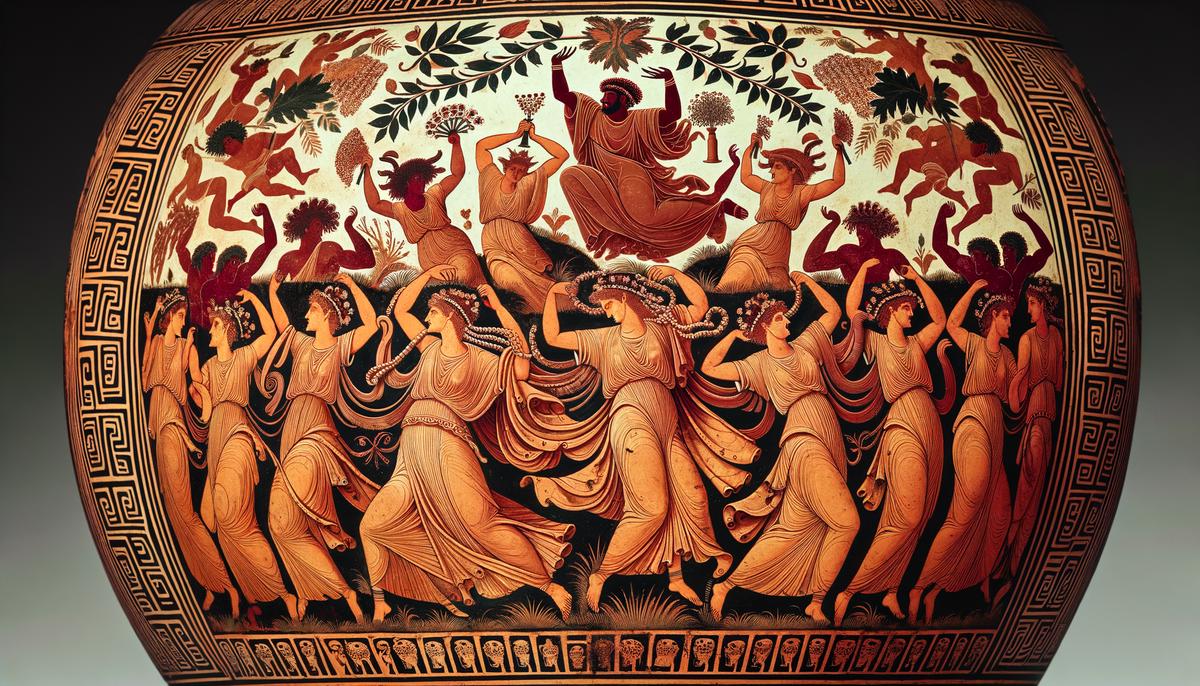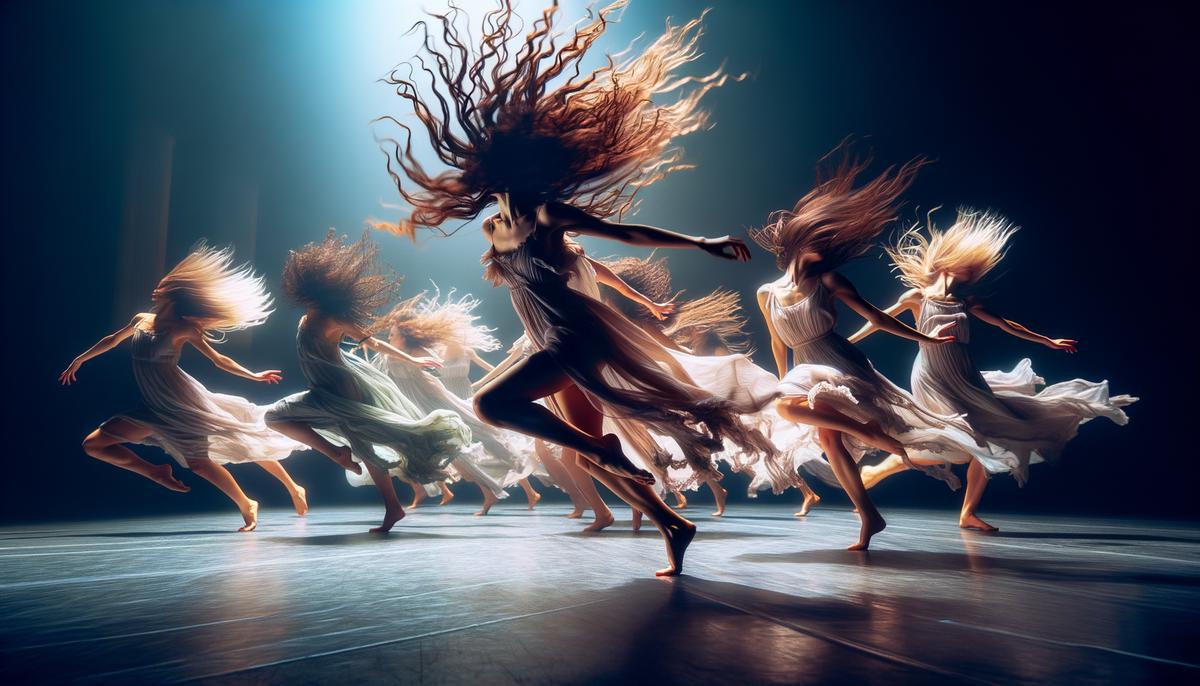Maenads, those spirited figures of ancient lore, embody a narrative rich with wild abandon and divine ecstasy. As we unravel the threads of their mythological tapestry, we find a vibrant portrayal of freedom and fervor that resonates deeply with the human spirit.
Origins and Worship
Maenads, also known as Bacchae, were devoted followers of Dionysus, the god of wine and revelry in ancient Greece. Many tales speak of them being struck by a divine madness sent by Dionysus himself, transforming everyday women into his frenzied followers.
Maenads were often decked out in fawn skins, leopard cloaks, and ivy garlands. These weren't just fashion statements but symbols with deep meaning: fawn skins representing the wild and ivy crowns magically connecting them to Dionysus. Their appearance conveyed a sense of being untamed, with hair flowing freely as they danced. They also carried the thyrsus, a staff topped with a pinecone, which held the power to summon wine from the ground.
The Maenads' dances were wild, eruptive, and uninhibited, deeply connected with nature's spirit. Their chants and rituals aimed for collective ecstasy, representing unity with Dionysus. It was a full-body and soul experience, releasing deep-seated emotions and harmonizing with the divine. High on mystic energy and moving rhythmically under the trees, these rituals manifested Dionysian joy and power.
The Maenads' appearance and accessories weren't mere spectacle. They connected them to Dionysus's core themes: fertility, wildness, and unrestrained freedom. Guided by frenzied rituals and deep mythological roots, Maenads worshipped Dionysus with a profound spiritual ecstasy unmatched in its explosive divine affection.

Symbolism and Powers
The Maenads embodied untamed liberty, breaking free from societal norms. They relished in a raw, unfiltered existence, liberated from everyday roles and expectations. Maenads represented the primal pulse of nature—wild and cathartic.
By wearing animal skins and dancing ecstatically, Maenads blurred the lines between human and nature, civilization and wilderness. Their chants and movements reconnected them with ancient, primal roots deeper than structured city life.
The Maenads' supernatural powers weren't just party tricks. Communicating with animals symbolized restoring dialogue with the wild world that humans had silenced. Their ability to raise the dead could be seen as a metaphor for rekindling life where it was thought lost, reviving dormant zest amidst mortal solemnity.
These enchanting powers emerged when Maenads surrendered to Dionysian ecstasy. By yielding to intense emotion and grounding themselves in the earth, they might have discovered secrets to manipulating life-force or manifesting vivid visions.
Maenads danced on the edge of civilization, mingling with moonlight and mist, coaxing nature to whisper and frolic. They were moving manifestos for living unrestrained, balancing bravely between the human and divine.
Maenads in Art and Literature
Maenads have been a fervent subject in art and literature. They prance prominently across ancient Greek pottery, depicting ecstatic revels and divine connections. Amidst ochre and crimson tales, Maenads are shown mid-dance, thyrsi in hand, encircled by satyrs and vines.
Sculptures have also captured their frenetic passion. Marbles from antiquity freeze Maenads in eternal euphoria, ranging from dignified solemnity to wild exuberance. They stand draped in deer skins or hinted-at attire, with hair flowing freely. Each curve on the marble pulses with untamed life.
In ancient plays like Euripides' "The Bacchae", Maenads are painted as forces of nature—inevitable, destructive, yet necessary for breaking down stifling norms. In the story, Pentheus, the skeptical king of Thebes, denies Dionysus and is torn apart by his own mother and her fellow Maenads in a god-granted madness. This tragic end reflects the Maenads' dual role as life-givers and death-dealers in Greek mythology.
These depictions of Maenads are both enchanting and horrifying, reflecting the bacchanalian corners of the human soul. They hold a mirror to the supernatural proportions of raw emotion and primal instinct.
Artists and poets have retold the Maenads' ritual renaissance across various works, creating a spinning mosaic that straddles the real and ethereal. These narratives and visual feasts capture not just dizzying festal drones but also a siren call to break free from conventional chains. They offer a rhythm, both haunting and inspiring, that ties wilderness to civilization.

Cultural Impact and Modern Interpretations
Maenads were more than just ecstatic dancers or mythical figures. They were powerful socio-cultural agents, carving out an unexpected niche for women in ancient Greek society. Greek women, typically confined to the private sphere, found a form of freedom in the worship of Dionysus. While decked in animal skins and rattling societal norms, Maenads effectively embraced a role that wove feminine mystique into public and spiritual domains.
These fervent females shifted perceptions, offering a glimpse of empowerment within structured societies. One can't help but wonder if whispers of their unrestrained agency trickled down through the ages, influencing feminist thought.
In modern times, Maenads continue to sway into attention across various media and literature. Characters inspired by these heady figures pop up in gritty TV dramas, poetic performances, and rich literary retellings. Their resurgence stirs discussions around their roles in society, mirroring expressions of female autonomy in modern feminism.
Contemporary fascination breathes new life into these ancient rites. Playwrights and screenwriters harness the spiritual anarchism of Maenads to critique or celebrate today's societal norms. In clubs pulsating under modern bacchanalias, echoes of Maenads' drums throb with primal liberation and intoxicating revolt.
As retellings flare through modern media, audiences are digesting slices of yesteryear deeply inscribed with twisted tales—dances that roared at repression and flung forth feminist cores. Each call heard in theaters and spied in novels cements Maenads not just as wild articulations of archaic reverence but as potent icons of cultural awakening. They represent an intrepid dance between heroism and heresy that twinkles into today's searching silver screens.

Controversial Aspects
One of the most unsettling aspects of Maenad worship in ancient Greece was the practice of sparagmos—the ritual tearing apart of a live animal (or, according to some chilling legends, even humans) in homage to Dionysus. This gruesome rite undoubtedly wins the trophy for 'most likely to be misunderstood by the neighbors'.
These spirited ladies, in their divine trance, were believed not only to uproot trees with their bare hands but also to dismantle any creature that crossed their ecstatic parade. You might imagine this also became quite controversial, meshing poorly with neighbours who were likely less enthused about livestock going missing. Outside of those entranced by Bacchic fever, such visceral rituals rattled societal cages, marking Maenads as disruptive to public order and moral decorum.
Dionysian practices, widely looked at askance by the more staid segments of society, wove tales of unease around the chaotic empowerment embodying the Maenad frenzy. Aristocrats and scholars alike bemoaned the disorderly overturning of societal norms. These frenzied festivities threw a wrench into the well-oiled machinery of civic Greek life. Elders feared that young spirits might be drawn away from sober civil duties and towards the unbridled revelry offered by gods of wine and ecstasy.
Darkening the shadow of revelry are notions, rooted in misogyny, about the inherent 'uncontrollability' of women—a principle both preserved and propagated by patriarchal anxiety toward free-spirited feminine assemblies. The label of divinely possessed madwomen served patriarchal agendas as a convenient summary of the potential horrors of unchecked female autonomy and spirituality.
Over the centuries, perceptions simmered toward a profound reevaluation. What once was slammed as unbridled hysteria has sprouted anew in more enlightened interpretations appreciating powerful assertions against stringent norms. Modern reconstructions champion spirituality and personal liberty—painting Maenads less like crazed fiends and more like pioneers in self-expression and feminist assertion.
Their symbolic legacy has pulsed through works as visceral manifestos against oppressive binds. Maenads' controversial outrages strike chords in modern climates where movements disrupt to demand overdue rights.
In essence, Maenads embody organizations in flux between adoration and renewation, shaping deep cultural roots and stories layered with inherent humor. The exploration rekindles perceptions, scaling what free-spiraling myths mean or invoke in the image of timeless Maenads whirling modern worship.
What lures fascination is the storytelling vessel cast betwixt Dionysus' blessed dance, entrancing visions molding aims to exalt yet brood in marching marvel, bold and panoramic, rendering historical gospel in prismatic, dance-stricken dives fueling hearts craving folds adjourn in multilayered monumental ferment—Maenads enchant touchstones refined in narrative jolts teasing wild honor past civic bounds.

In the whirlwind of myth and reality, the Maenads stand as a powerful symbol of unbridled freedom and spiritual fervor. Their story is not just a historical echo but a continuous call to embrace the wild, untamed corners of our souls.

Leave a Reply